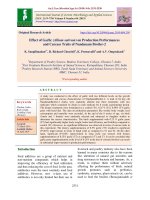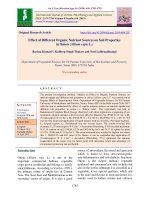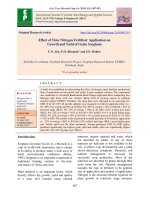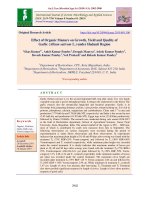Effect of feeding garlic (Allium sativum) on haematological, serum biochemical profile and carcass characteristics in broiler chicken
Bạn đang xem bản rút gọn của tài liệu. Xem và tải ngay bản đầy đủ của tài liệu tại đây (223.47 KB, 9 trang )
Int.J.Curr.Microbiol.App.Sci (2019) 8(10): 492-500
International Journal of Current Microbiology and Applied Sciences
ISSN: 2319-7706 Volume 8 Number 10 (2019)
Journal homepage:
Original Research Article
/>
Effect of Feeding Garlic (Allium sativum) on Haematological, Serum
Biochemical Profile and Carcass Characteristics in Broiler Chicken
Bondona Borgohain, Joga Dev Mahanta, Deben Sapcota,
Bornalee Handique* and Rafiqul Islam
College of Veterinary Science, Assam Agricultural University, Khanapara,
Guwahati-781022, Assam, India
*Corresponding author
ABSTRACT
Keywords
Broiler chicken,
Carcass
characteristics,
Garlic,
Haematological,
Serum biochemical
Article Info
Accepted:
07 September 2019
Available Online:
10 October 2019
A total of 144 day old broiler chicks (Cobb-400 Y) were randomly
distributed into four groups (3 replicates of 12 chicks) using randomization
block design viz. T0 contained no garlic powder supplementation while diet
T1, T2 and T3 contained 0.5, 1.0 and 1.5% of garlic powder, respectively
along with probiotic powder named probios. Haemoglobin, total RBC,
Cholesterol, Triglycerides, HDL and LDL were differed significantly
(P<0.05) among different treatment groups. Significantly (P<0.05) lowest
cholesterol was recorded in T3 and T2 group as compared to T1. The per
cent yield of cut-up parts like neck, wing, back, breast, thigh, drumstick and
relative weight of organs on dressed weight basis did not differ
significantly among different treatment groups except the per cent weights
of liver, gizzard, lungs and abdominal fat. The study revealed that garlic
supplementation in commercial broiler diet reduced serum cholesterol,
triglycerides and minimizes excessive fat deposition in broiler carcass.
Introduction
Broiler farming has emerged as the most
profitable business for self employment
among the rural society. The fast growing
nature of broiler chickens and their short
generation interval have been associated over
the years with the use of antibiotic growth
promoters in animal feeds in order to improve
the quality of the product. However, the use of
antibiotic based growth promoters is presently
facing serious problem and has raised global
concern as some reports revealed their ill
effects among which are development of
microbial resistance to the products and their
potential harmful effects on human health
(Rahmatnejad et al., 2009). Moreover,
antibiotics lead to drug resistance in bacteria
492
Int.J.Curr.Microbiol.App.Sci (2019) 8(10): 492-500
and drug residues in meat (Issa and Omer,
2012). These lead to the search for alternative
substances that eliminate these threats.
Probiotics, Prebiotics and medicinal plants as
natural feed additives are currently used in
poultry diets to enhance the performance and
immune response of birds. Garlic (Allium
sativum) which belongs to the family
Alliaceae and the genus Allium (Eric, 2010) is
widely distributed and used in all over the
world as a spice and herbal remedy for the
prevention and treatment of variety of diseases
(Javandel et al., 2008). These functions are
mainly attributed to the bioactive components
present in garlic (Amagese et al., 2001), which
is a sulpher containing organic compound
known as diallyl polysulphide which possess
antimicrobial activity (Tsao and Yin, 2001)
that could be responsible for the growth
promoting effects of garlic. Qureshi et al.,
(1983) concluded that garlic has the tendency
to lower serum and liver cholesterol. To
enhance the activity of these probiotics,
prebiotics are essential. Inulin is present in
significant quantities in several vegetables
specially garlic. The inulin content of garlic on
dry weight basis was reported as 9-16%
(Source: RemadySpot.com).
Materials and Methods
The experiment was conducted in the
experimental poultry shed of Instructional
Poultry Farm, College of Veterinary Science,
Assam Agricultural University, Khanapara781022. The experimental protocol was
approved by the Institutional Animal Ethics
Committee (IAEC) with approval No.
770/ac/CPCSEA/FVSc/AAU/IAEC/15-16/349
and carried out as per the guidelines of
Committee for the Purpose of Control and
Supervision of Experiments in Animals
(CPCSEA), Ministry of Environment, Forests
and Climate Change, Government of India. A
total of 144 day old broiler chicks (Cobb-400
Y) randomly distributed into four groups (3
replicates of 12 chicks) using randomization
block design viz. T0 contained no garlic
powder supplementation while diet, T1, T2 and
T3 contained 0.5, 1.0 and 1.5% of garlic
powder, respectively. All the experimental
groups (T0, T1, T2 and T3) were fed
commercial brand of probiotic powder (Trade
name- Probios, manufactured by Stallen South
Asia Pvt. Ltd., Thane, Maharastra) at the
recommended dose of 1g/litre of drinking
water. This Probios contained Bifidobacterium
bifidum, Lactobacilluc acidophilus, L.
bulgaricus, L. casei, L. plantarum, L. faecium
and Streptococcus thermophilus, yeastTorulopsis spp, Aspergillus coryza. The
broiler starter and finisher diets were prepared
as per BIS (1992) recommendation. The
composition and nutritive value of basal diets
are shown in Table 1. All the chicks were
given ad libitum access to feed and water. The
chicks were vaccinated against Ranikhet
disease with Lasota strain (F1) and Infectious
Bursal Disease (IBD) vaccine on 7th and 14th
day of age, respectively.
At the end of the experiment, six birds from
each group were selected for collection of
blood sample from the wing vein. For
estimation of haematological parameter blood
was collected aseptically with anticoagulant
and estimated using automatic haematolyzer.
For estimation of total serum biochemical
profile blood was collected aseptically from
the birds. The blood samples were brought to
the laboratory without disturbing the clots and
centrifuged at 3000 rpm for 15 min. to collect
serum and stored at -20°C till further analysis.
Serum biochemical profiles were estimated by
spectrometric method (dual beam UVSpectrometer) using commercial kits (Coral
Clinical System, Uttrakhand, India).
Birds were slaughtered for the carcass
parameters at the end of the experimental trial.
The birds were fasted overnight and preslaughter weights were recorded. The dressed
493
Int.J.Curr.Microbiol.App.Sci (2019) 8(10): 492-500
weight of each group was obtained separately
after complete bleeding and removal of
feathers, viscera, head and legs by keeping the
skin intact with the carcass and calculated as
percent of pre-slaughter weight. The neck,
wing, back, drumstick, thigh and breast meat
were weighed seperately and divided by preslaughter weight to determine relative weight
and expressed as percentage. Fat around the
abdominal wall was removed and weighed and
calculated as percentage preslaughter weight.
The edible visceral organs (heart, liver and
gizzard) and lymphoid organs were weighed
individually after separating from viscera. The
total weight of small intestine along with
caecal content was taken and calculated as
percent of pre-slaughter weight.
Results and Discussion
Haematological parameters
All the haematological parameters except
haemoglobin and total RBC recorded in the
present study differed significantly (P<0.05)
among different treatment groups (Table 2).
Contrary to the present result, Ayeni et al.,
(2008) and Jimoh et al., (2012) stated that
haematological
parameters
were
not
significantly
affected
by
garlic
supplementation of the broilers diets. The
PCV percentage recorded in T1 and T2 (24.60
and 24.72) group was significantly (P<0.05)
higher as compared to T0 group (21.54). This
result corroborated with the findings of Elagib
et al., (2013) who found numerically higher
PCV values (24.00 and 23.70) in garlic treated
groups as compared to control (22.00). The
total WBC, WBC differential count
(Neutrophil, Eosinophil, Monocyte and
Lymphocyte) recorded in the present study
was significantly (P<0.05) higher in T2 and T3
groups as compared to T0 and T1 group.
Contrary to the present results, Elagib et al.,
(2013) found no significant effect (P>0.05) on
the differential count of WBC in broiler
chicken supplemented with 3 and 5 per cent of
garlic powder in feed. Fadlalla et al., (2010)
who reported significantly (P<0.05) higher
total WBC (820.50 million/mm3) in garlic
treated (0.3%) groups as compared to control.
Serum biochemical parameters
The mean values of ALT, total serum
cholesterol, triglycerides, HDL and LDL
except serum glucose were differed
significantly (P<0.001) among different
experimental groups (Table 3). The total
serum cholesterol was significantly lowest in
T3 and T2 (109.48 and 110.89 mg/dl) as
compared to T0 and T1 group (165.01 and
146.48 mg/dl). These results agreed with
Prasad et al., 2009 and Issa and Omer, 2012
who reported that dietary supplementation of
garlic powder at different concentrations
caused a significant decrease in the mean
values of total cholesterol, LDL and
Triglycerides while HDL was significantly
increased in broiler chicken up to 8 weeks of
age in comparison to control group. This
might be due to possible mechanisms of
hypocholesterolaemic and hypolipidemic
action of garlic which depresses the hepatic
activities of lipogenic and cholesterogenic
enzymes such as malic enzyme, fatty acid
synthase,
glucose-6-phosphatase
dehydrogenase (Qureshi et al., 1983 and Chi
et al., 1982) and 3-hydroxyl-3-methylglutaryl-CoA (HMG-CoA) reductase (Qureshi
et al., 1983).
Carcass characteristics
Carcass quality trait
All carcass quality traits (live weight, dressed
weight, dressing percentage and giblet weight)
except giblet yield percentage recorded in the
present study did not differ significantly
(P<0.05) among different treatment groups
(Table 4). These findings were in agreement
494
Int.J.Curr.Microbiol.App.Sci (2019) 8(10): 492-500
with the reports of Javandel et al., (2008),
Amouzmehr et al., (2013) and Kharde and
Soujanya (2014), who reported that
supplementation of garlic had no significant
effects on major carcass characteristics
including the dressing percentage. However
Raeesi et al., (2010) and Eltazi et al., (2014)
found significant differences in carcass traits
including the dressing percentage in broiler
chicken due to supplementation of garlic
powder in feed.
Cut up parts
The per cent yield of cut-up parts like neck,
wing, back, breast, thigh and drumstick did
not differ significantly (P>0.05) among
different treatment groups (Table 5). Similar
observations were reported by Amouzmehr et
al., (2013) and Milosevic et al., (2013) who
found no significant differences in the per cent
yield of drumstick, breast and thigh among the
control and garlic fed treated groups. Contrary
to the present findings, Ademola et al., (2004)
found significant (P<0.05) differences in
weights of wing and drumstick among
different treatment groups. Raeesi et al.,
(2010) also found significant (P<0.05)
differences in per cent yield of thigh and
breast among the control and garlic treated
groups.
Relative organ weights
The mean per cent weights of relative organs
on Dressed Weight Basis (DWB) under
different treatment groups are presented in
Table 6. The per cent weights of relative
organs of broiler chicken on dressed weight
basis did not differ significantly (P>0.05)
among different treatment groups except the
per cent weights of liver, gizzard, lungs and
abdominal fat. The per cent weights of liver,
gizzard, lungs and abdominal fat of T0 group
(2.41, 2.48, 0.97 1.31 per cent) were
significantly (P<0.05) higher than the garlic
fed groups. This implies that this level is
appropriate for the birds and that the test diets
did not contain any appreciable toxin.
According to Bone (1979) abnormalities in the
weights of the internal organs like liver,
kidney and gizzard arise because of increased
metabolic rate of the organs in attempt to
reduce toxic elements or anti-nutritional
factors to non-toxic metabolites. Garlic fed
bird exhibited higher liver mass as compared
to control group. Onibi et al., (2009) in their
study on the effect of garlic on performance
and meat quality of the broiler chicken found
that organ characteristics of chicken were not
significantly affected (P>0.05) by dietary
supplementation but abdominal fat contents
were
numerically
lowered
due
to
supplementary garlic.
Contrary to the present findings, Fayad et al.,
(2011) and Issa and Omer, (2012) found no
significant differences in per cent yield of
gizzard among different treatment groups.
Similar to the present finding, Ademola et al.,
(2004) also found significant (P<0.05)
differences in the mean weights of liver and
lungs due to supplementation of garlic powder
in feed.
In the present findings, it was observed that
the garlic supplement elicited significant
(P<0.05) decrease of the abdominal fat content
of the experimental birds of T1, T2 and T3
group as compared to control group. The
present findings corroborated with the reports
of Raeesi et al., (2010), Jimoh et al., (2012)
and Oleforuh-Okoleh et al., (2014) who found
significant (P<0.05) depression of weights of
abdominal fat in carcasses of broiler chicken
supplemented with garlic powder in feed. The
reduction in the percentage of abdominal fat in
garlic supplemented powder may be attributed
to the action of garlic which has been reported
to possess lipid lowering effects (Agarwal,
1996).
495
Int.J.Curr.Microbiol.App.Sci (2019) 8(10): 492-500
Table.1 Percent ingredient and nutrient composition of the experimental basal diet
Ingredients (kg)
Starter (0-28 days)
Finisher (29-42 days)
Percent Ingredient Composition
42.0
14.0
25.0
10.0
7.0
1.5
Maize
Rice polish
Ground nut cake
Soyabean meal
Fish meal
Mineral mixture
Common salt
50.5
15.0
16.0
10.5
6.0
1.5
0.5
Nutrient compositionon DM basis (%)
Dry matter (%)
Crude protein (%)
Ether Extract (%)
Crude Fibre (%)
Nitrogen free extract (%)
Total ash (%)
Metabolizable energy (kcal/kg)*
88.92
23.04
4.89
5.81
59.44
7.01
2850.85
0.5
88.95
20.12
5.01
6.11
60.52
6.98
2913.41
*Calculated values
(N.B. Vitamin premix (Vitablend vit A, B 2, D3, K) was added @ 20 g per quintal of diet in both starter and finisher
diet. Mineral mixture contained calcium 25%, Phosphorus 5%, Sodium chloride 23%, Iodine 10 ppm, Copper 100
ppm, Manganese 2000 ppm and Cobalt 10 ppm).
Table.2 Effect of feeding Garlic (Allium sativum) on haematological parameters in commercial
broiler chicken
Parameters
Haemoglobin (g/dl)
PCV (%)
Total RBC (million/ mm3 )
Total WBC (million/ mm3 )
Neutrophil (million/ mm3 )
Eosinophil (million/ mm3 )
Monocyte (million/ mm3 )
Lymphocyte (million/ mm3 )
T0
(Control)
9.60 ± 0.32
21.54a±0.63
2.11 ± 0.05
71.12a ± 1.82
4.16a ± 0.14
0.52a ± 0.07
0.91a ± 0.03
64.19a ± 1.78
T1
(GP-0.5%)
10.12 ± 0.31
24.60b ± 0.75
2.12 ± 0.05
72.52ab ± 1.93
4.32ab ± 0.13
0.63ab ± 0.06
0.99ab ± 0.03
66.26ab ± 1.65
abc
T2
(GP-1.0%)
10.50 ± 0.39
24.72bc ±1.24
2.10 ± 0.06
85.69c ± 2.18
4.52abc ± 0.11
0.76c ± 0.09
1.08c ± 0.06
70.58c ± 1.00
Mean values with different superscripts within row differ significantly.
** Significant at P<0.001; *Significant at P <0.05; NS- Non Significant at P > 0.05
496
T3
(GP-1.5%)
9.74 ± 0.38
23.20abc ±0.68
2.03 ± 0.05
85.11c ± 1.46
4.69c ± 0.11
0.89c ± 0.09
1.12c ± 0.03
71.89c ± 0.97
P value
NS
*
NS
**
*
*
**
**
Int.J.Curr.Microbiol.App.Sci (2019) 8(10): 492-500
Table.3 Effect of feeding Garlic (Allium sativum) on serum biochemical profile in commercial
broiler chicken
Parameters
Serum glucose
ALT (U/ml)
Total
cholesterol
(mg/dl)
Triglycerides
(mg/dl)
HDL (mg/dl)
LDL (mg/dl)
T0
(Control)
T1
(GP-0.5%)
T2
(GP-1.0%)
T3
(GP-1.5%)
P value
248.20 ±8.62
26.29a ± 0.74
165.01a±2.66
243.00 ±6.82
26.02ab ± 0.39
146.48b±6.65
247.00±1.09
23.27c ± 0.55
110.89c±2.25
244.20±2.78
25.32ab± 0.31
109.48c ±2.23
NS
*
**
103.74a±2.91
81.84b ± 2.18
53.74c ± 2.76
50.43c ± 3.11
**
47.42a ± 3.99
96.85a ± 4.88
57.47ab±10.36
61.59b ± 7.59
82.02c ± 3.57
18.27c ± 3.85
83.13c ± 3.46
16.21c ± 4.31
**
**
abc
Mean values with different superscripts within row differ significantly.
** Significant at P<0.001; *Significant at P <0.05; NS- Non Significant at P > 0.05
Table.4 Effect of feeding Garlic (Allium sativum) on carcass traits in commercial broiler chicken
Parameters
Live weight (g)
Dressed weight (g)
Dressing percentage (%)
Giblet weight (g)
Giblet yield (%)
T0
(Control)
1891.25±53.1
1362.44±44.2
71.98±0.69
103.60± 3.01
5.61a ± 0.17
T1
(GP-0.5%)
1945.88±74.05
1388.68±61.78
71.27± 0.88
98.50 ±3.03
5.08b ±0.10
T2
(GP-1.0%)
2084.48±80.28
1506.38±62.75
72.19± 0.8
101.75±3.93
4.88bc ±0.05
T3
(GP-1.5%)
2020.25± 82.90
1451.50± 57.61
71.89 ± 0.87
97.9 ±3.83
4.85bc ±0.09
abc
Mean values with different superscripts within row differ significantly.
** Significant at P<0.001; *Significant at P <0.05; NS- Non Significant at P > 0.05
Table.5 Effect of feeding Garlic (Allium sativum) on per cent yeild cut up parts in commercial
broiler chicken
T0
(Control)
T1
(GP-0.5%)
T2
(GP-1.0%)
T3
(GP-1.5%)
P value
Parameters
Neck
Wing
Back
Breast
Thigh
Drumstick
6.32± 0.23
10.56 ± 0.25
17.33 ± 0.69
32.68 ± 0.94
14.52 ± 0.59
12.99 ± 0.33
5.93 ± 0.41
10.46 ± 0.48
17.41 ± 0.62
32.22 ± 0.85
14.56 ± 0.55
13.15 ± 0.45
6.39 ± 0.54
11.28 ± 0.51
17.51 ± 0.81
32.78 ± 0.81
14.72 ± 0.41
13.48a ± 0.24
6.10 ± 0.36
10.33 ± 0.31
17.44 ± 0.49
32.44 ± 0.65
14.69 ± 0.68
13.35 ±0.13
NS
NS
NS
NS
NS
NS
** Significant at P<0.001; *Significant at P <0.05; NS- Non Significant at P > 0.05
497
P
value
NS
NS
NS
NS
*
Int.J.Curr.Microbiol.App.Sci (2019) 8(10): 492-500
Table.6 Effect of feeding Garlic (Allium sativum) on per cent weight of relative organs and
lymphoid organs (on DWB) in commercial broiler chicken
Parameters
T0
(Control)
Liver
Heart
Gizzard
Head
Shank
Intestine
Lungs
Kidney
Pancreas
Abdominal fat
2.41a ± 0.11
0.59 ± 0.03
2.48a ± 0.09
3.51 ± 0.19
4.98 ± 0.15
5.94 ± 0.52
0.97a ± 0.03
0.25 ± 0.03
0.31 ± 0.05
1.31 ± 0.03
Spleen
Thymus
Bursa
2.31a ± 0.05
5.06 ± 0.19
1.28 ± 0.02
T1
(GP-0.5%)
T2
(GP-1.0%)
T3
(GP-1.5%)
P value
2.16a ± 0.03
2.07b ± 0.06
0.56 ± 0.05
0.59 ± 0.02
a
2.35 ± 0.07
2.21bc ± 0.05
3.49 ± 0.21
3.45 ± 0.11
5.13 ± 0.31
5.25 ± 0.17
5.81 ± 0.58
5.87 ± 0.57
b
0.93 ± 0.02
0.72b ± 0.04
0.30 ± 0.04
0.28 ± 0.06
0.25 ± 0.02
0.30 ± 0.01
b
1.22 ± 0.04
0.71c ± 0.02
Lymphoid organs
2.27ab ± 0.04
1.68c ± 0.07
5.03 ± 0.18
5.18 ± 0.17
1.28 ± 0.03
1.24 ± 0.02
2.09b ± 0.03
0.56 ± 0.05
2.19c ± 0.05
3.46 ± 0.03
5.13 ± 0.13
5.87 ± 0.46
0.69b ± 0.02
0.27 ± 0.05
0.24 ± 0.02
0.67c ± 0.02
*
NS
*
NS
NS
NS
**
NS
NS
**
1.72c ± 0.07
5.09 ± 0.19
1.27 ± 0.02
**
NS
NS
abc
Mean values with different superscripts within row differ significantly.
** Significant at P<0.001; *Significant at P <0.05; NS- Non Significant at P > 0.05
Lymphoid organs
Among the lymphoid organs, both bursa and
thymus showed no significant (P≥ 0.05)
difference in per cent weights between the
different treatments groups (Table 5).
However, the per cent weights of spleen
differed significantly (P<0.05) among
different experimental groups. The spleen
weight decreased significantly (P<0.05) in T2
and T3 group as compared to T0 and T1. This
might be due to the antimicrobial properties of
garlic. The present findings were in agreement
with the observations of Elagib et al., (2013)
wherein, they found no significant (P>0.05)
difference in both weights of bursa and
thymus between different treatment with 3 and
5 % garlic powder and spleen weight
decreased significantly (P<0.05) in garlic
treated groups as compared to control.
Contrary to the present observation, Raeesi et
al., (2010) found significant (P<0.05)
differences in per cent yield of bursa among
different treatment groups. However, they
reported that the relative weights of spleen
were higher in unsupplemented group.
Dietary supplementation of garlic reduced the
accumulation of abdominal fat pad and
decreased serum cholesterol and triglycerides
level in the commercial broilers. Dietary
supplementation
of
garlic
exhibited
hypocholesterlaemic
and
hypolipidemic
effects on the broiler chicken and could
therefore be supplemented in broiler diet to
minimize excessive fat deposition in broiler
carcass however, further studies are required
to ascertain the findings of the present study.
References
Ademola, S. G., Farinu, G. O., Obe, A. O. A.
and Babatunde, G. M. 2004. Growth,
haematological
and
biochemical
studies on garlic- and ginger-fed
broiler chickens. Moor Journal of
498
Int.J.Curr.Microbiol.App.Sci (2019) 8(10): 492-500
Agricultural Research. 5: 122-128.
Agarwal, K. C. 1996: Therapeutic actions of
garlic constituents. Med. Res. 16: 111124.
Amagese, H., Petesch, B., Matsuura, H.,
Kasuga, S. and Itakura, Y. 2001.
Recent advances on the nutritional
effects associated with the use of garlic
as a supplement: Intake of garlic and
its bioactive components. The Journal
of Nutrition. 131: 955S-962S.
Amouzmehr, A., Daster, B., Nejad, J.G.,
Sung, K.I., Lohakare, J. and Forghani,
F. 2013. Effect of garlic and thyme
extracts on growth performance and
carcass characteristics of broiler
chicks. Journal of Animal Science
Technology. 54: 185-190.
Ayeni, O. E., Alokan, J. A. and Onihi, G. E.
2008. Performance and meat quality of
broiler chickens fed diets containing
supplementary garlic (Allium sativum).
Federal University Technology. Akure.
BIS. 1992 Indian Standard: Poultry Feed
Specifications. 4th Revision. Bureau of
Indian Standards, New Delhi.
Bone, F.J. 1979. Anatomy and physiology of
farm animals. Reston, USA.
Chi, M. S., Koh, H. and Steward, T. J. 1982.
Effects of garlic on lipid metabolism in
rat fed cholesterol or lard. The Journal
of Nutrition.. 112:241-248.
Elagib, H. A. A., El-Amin, W. I. A., Elamin,
K. M. and Malik, H. E. E. 2013. Effect
of dietary garlic (Allium sativum)
supplementation as feed additive on
broiler performance and blood profile.
Journal of Animal Science. 3: 58-64.
Eric B. 2010. “Garlic and Other Alliums: The
Lore and the Science.” Cambridge,
Royal Society of Chemistry. 34:152166.
Fadlalla, I. M. T.; Mohamed, B. H. and
Bakhiet, A. O. 2010. Effect of feeding
garlic on the performance and
immunity of broilers. Asian Journal of
Poultry Science.3:182-189.
Fayad, R. H., Razek, A. H. A.; Jehan and Ouf,
M. 2011. Effect of dietary garlic
supplementation on performance,
carcass traits, and meat quality of
broiler chickens. ISAH Congress,
Vienna, 15:1-4.
Issa, K. J. and Omer, J. M. A. 2012. Effect of
garlic powder on performance and
lipid profile of broilers. Open Journal
of Animal Science. 2: 62-68.
Jafari, R. A., Jalali, M. R., Ghorbanpoor, M.
and Saraei, M. R. M. 2008. Effect of
dietary garlic on immune response of
broiler chicks to live Newcastle
disease vaccine. Pakistan Journal of
Biological Science. 11: 1848-1851.
Javendel, F., Blaridshad, B., Seifarati, J.,
Pourrahimi, A. H. and Baniyaghoub, S.
2008. The favorite dosage of garlic
meal as a feed addictive in broiler
chickens ration. Pakistan Journal of
Biological Science. 11: 1746-1749.
Jimoh, A. A., Olorede, B. R.; Abubakar, A.,
Fabiyi, J. P.; Ibitoye, E. B., Suleiman,
N. and Garba, S. (2012). Lipids profile
and haematological indices of broiler
chickens fed garlic (Allium sativum)
supplemented diets. Journal of
Veterinary Advance. 2: 474-480.
Kharde, K. R. and Soujanya, S. 2014. Effect
of garlic and neem leaf powder
supplementation
on
growth
performance and carcass traits in
broilers. Veterinary World. 7: 799-802.
Milosevic, N., Stanacev, V., Peric, L.; Stojcie,
M. D. and Veljic, M. 2013. Effects of
different levels of garlic powder in the
diet on production parameters and
slaughter traits of broiler chickens.
Arch. Geflugelk. 77:254-259.
Oleforuh-Okoleh, V. U., Chukwu, G. C. and
Adeolu, A. I. 2014. Effect of ground
ginger and garlic on the growth
performance, carcass quality and
economics of production of broiler
499
Int.J.Curr.Microbiol.App.Sci (2019) 8(10): 492-500
chickens. Global Journal of Biological
Science and Biotechnology. 3: 225229.
Onibi, G. E., Adebisi, O. E., Fajemisin, A. N.
and Adetunji, A. V. 2009. Response of
broiler chickens in terms of
performance and meat quality to garlic
(Allium sativum) supplementation.
African Journal of Agricultural
Research. 4: 511-517.
Onu, P. N. 2010. Evaluation of two herbal
spices as feed additives for finisher
broilers. Biotechnology in Animal
Husbandry. 26: 383 - 392.
Prasad, R., Rose, M. K., Virmani, M., Garg, S.
L and Puri, J. P. 2009. Lipid profile of
chicken (Gallus domesticus) in
response to dietary supplementation of
garlic (Allium sativum). International
Journal of Poultry Science. 8: 270-276.
Qureshi, A. A., Din, Z. Z., Abuirmeileh, N.,
Burger, W. C. and Elson, C. E. 1983.
Inhibition of cholesterol and fatty acid
biosynthesis in liver enzymes and
chicken hepatocytes by polar fractions
of garlic. Lipids. 18:343-348. Doi:
10.1007/BF02537229
Raeesi, M., Hoseini- Aliabad, S. A.,
Roofchaee, A., Zare Shahneh, A. and
Pirali, S. 2010. Effect of periodically
use of garlic (Allium sativum) powder
on
performance
and
carcass
characteristics in broiler chickens.
World
Academy
of
Science,
Engineering and Technology. 68:
1213- 1219
Rahmatnejad,
E.,
Roshanfekr,
H.,
Ashayerizadeh, O., Mamooee, M. and
Ashayerizadeh, A. 2009. Evaluation
the effect of several non-antibiotic
additives on growth performance of
broiler chickens. Journal of Animal
and Veterinary Advances. 8: 16701673.
Tsao, S. M. and Yin, M. C. 2001. In vitro
activity of garlic oil and four diallylsulfides against antibiotic resistant
Pseudomonas
aeruginosa
and
Klebsiella pneumoniae. Journal of
Antimicrobial Chemotherapy. 47: 665670.
How to cite this article:
Bondona Borgohain, Joga Dev Mahanta, Deben Sapcota, Bornalee Handique and Rafiqul
Islam. 2019. Effect of Feeding Garlic (Allium sativum) on Haematological, Serum Biochemical
Profile and Carcass Characteristics in Broiler Chicken. Int.J.Curr.Microbiol.App.Sci. 8(10):
492-500. />
500

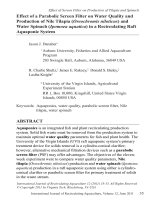

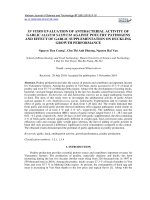

![Effect of different plant growth regulators on shooting of stem cuttings in dragon fruit [Hylocereus undatus (Haworth) Britton & Rose]](https://media.store123doc.com/images/document/2020_01/09/medium_isb1578564896.jpg)
